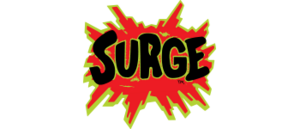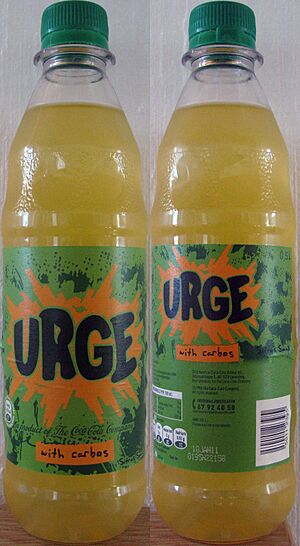Surge (drink) facts for kids
 |
|
| Type | Citrus soda |
|---|---|
| Manufacturer | The Coca-Cola Company |
| Country of origin | United States |
| Introduced | February 7, 1997 (original run) 2014 (Amazon-exclusive; revival) 2015 (Eastern United States) August 2018 (all Burger King and McDonald's Coca-Cola Freestyle machines) |
| Discontinued | 2003 (original run) |
| Color | Light Green |
| Related products | Citra/Fanta Citrus Mello Yello Mountain Dew Sprite Sun Drop Urge Vault |
Surge is a citrus-flavored soft drink made by The Coca-Cola Company. It first came out in the 1990s. Coca-Cola created Surge to compete with Pepsi's popular Mountain Dew drink. Surge was advertised as a more "extreme" drink, similar to how Mountain Dew was marketed.
Surge was first launched in Norway in 1996, where it was called Urge. It became very popular there, so Coca-Cola decided to release it in the United States in 1997. However, sales started to slow down, and Surge was stopped in most places by 2003.
But fans really missed Surge! Groups like the "SURGE Movement" on Facebook asked Coca-Cola to bring it back. Because of this, Surge was re-released on September 15, 2014. At first, you could only buy it online through Amazon Prime. Later, it became available in stores in the Eastern United States and some Mountain states in 2015. In 2018, Surge also became available in Burger King restaurants through Coca-Cola Freestyle machines.
Contents
The Story of Surge
How Surge Started
In 1997, Coca-Cola began making Surge in the United States. Its secret project name was "MDK," which stood for "Mountain Dew Killer." Coca-Cola wanted Surge to help slow down the growth of Mountain Dew. Earlier attempts with drinks like OK Soda or Mello Yello hadn't worked as well.
Surge was designed to be even better than Mountain Dew. It used an ingredient called maltodextrin to give a longer-lasting energy boost. It also had a bolder, brighter look. Coca-Cola spent a lot of money, about $50 million, to advertise Surge across the country. This led to high sales and made Surge very popular at first.
A few years after it came out, sales started to drop. Surge was still sold in vending machines and special tall promotional coolers in gas stations. These coolers were placed in busy areas to encourage people to buy Surge instead of other drinks. Surge was sold in cans and at soda fountains until it was stopped in 2003.
Before Surge launched in the US, the Norwegian Coca-Cola team needed help. Mountain Dew was doing very well in Norway. Since the name "Surge" was already used by another company there, the drink was launched as "Urge." Also, local rules meant they couldn't use the bright green color. So, Urge was a paler, more natural color and had a slight orange taste to match.
Until Surge was brought back in the US in 2014, Norway was the only country where you could still buy a similar drink. The original Surge recipe was still popular there as Urge.
Surge and Extreme Sports
Surge was often linked to the world of extreme sports. Its TV commercials were similar to those used by Mountain Dew at the time. Coca-Cola used exciting slogans to market Surge to teens and extreme sports fans. Some of these slogans included "Feed the Rush" and "Life's a Scream." They also called Surge "A Fully Loaded Citrus Soda."
The company also pointed out that Surge had a lot of carbohydrates. This was why they sometimes used the tagline "with carbos." It helped show that Surge was meant to be more than just a soda; it was also an energy drink.
After it first came out, Surge's logo was updated. A graphic designer named Colin Nekritz made it look sharper and more modern.
Bringing Surge Back
After Surge was stopped, a fan community called "Save Surge" was started by Eric Karkovack. This group first helped people find places where they could still buy Surge from soda fountains. When the fountain syrup was also stopped, the group kept going. They worked to get Coca-Cola to bring Surge back. Their efforts even led to a new citrus soda called Vault being released in 2005. After Vault came out, the "Save Surge" group closed down. Vault was later stopped in 2011.
When Vault was discontinued, a new group called the "Surge Movement" started on Facebook. This group kept asking Coca-Cola on their Facebook page to bring Surge back. They also encouraged their members to call Coca-Cola's customer service hotline every month. The "Surge Movement" gained about 200,000 "likes" on Facebook and continued to grow.
Because of this strong fan support, Surge was re-released on September 15, 2014. It was sold exclusively on Amazon.com in packs of twelve 16-ounce cans.
On February 10, 2015, Coca-Cola announced they were testing Surge again. They sold it through independent stores and vending machines in the Southeastern United States. This test ended in May 2015. Two months later, Coca-Cola said they were planning a bigger release for Surge in stores across the Eastern United States. Surge officially returned to convenience stores in the Eastern United States on September 7, 2015.
In August 2018, Surge became available in Coca-Cola Freestyle machines. You could find it only at Burger King restaurants. It came in different flavors like Cherry, Grape, Vanilla, and Zero Sugar.
Frozen Surge Drinks
On November 16, 2015, Burger King restaurants offered a frozen version of Surge called "Frozen Surge." It was a limited-time slushy drink. Burger King brought it back as a fountain drink in August 2018.
In late 2016, Valero Corner Stores teamed up with Icee. They started selling a slushy version of Surge at some of their locations.
On January 11, 2017, Cinemark movie theaters also released a frozen Surge drink called "Surge Frozen." This was also for a limited time and was stopped in Spring 2017.
What's in Surge?
People have often compared Surge to another Coca-Cola drink called Vault. Vault was first released in 2005, about two years after Surge was stopped. Vault was also discontinued in December 2011. Both drinks tasted similar. However, Vault had more caffeine, with 70.5 milligrams per 12-ounce serving. Surge had 51 milligrams of caffeine per 12-ounce serving, which was similar to other citrus sodas at the time.
The ingredients in Surge can be found on its labels. The ingredients might be slightly different depending on if it's a can, bottle, fountain syrup, or frozen drink syrup. The syrups are meant to be mixed with cold, carbonated water.
| Surge Can/Bottle (1997—2006) | Surge Fountain Syrup | Surge FCB Syrup | Surge Can (2014) |
|---|---|---|---|
| Carbonated Water | High Fructose Corn Syrup and/or Sucrose | High Fructose Corn Syrup and/or Sucrose | Carbonated Water |
| High Fructose Corn Syrup and/or Sucrose | Water | Water | High Fructose Corn Syrup |
| Maltodextrin | Maltodextrin | Maltodextrin | Maltodextrin |
| Citric Acid | Citric Acid | Citric Acid | Citric Acid |
| Natural flavors | Natural flavors | Natural flavors | Orange Juice Concentrate |
| Concentrated Orange juice | Concentrated Orange Juice | Concentrated Orange Juice | Natural flavors |
| Potassium Benzoate | Potassium Benzoate | Yucca Extract | Potassium Benzoate |
| EDTA and Erythorbic Acid | EDTA and Erythorbic Acid | Quillaia | Potassium Citrate |
| Potassium Citrate | Potassium Citrate | Potassium Benzoate | Caffeine |
| Caffeine | Caffeine | EDTA and Erythorbic Acid | Calcium Disodium EDTA |
| Yellow #5 | Yellow #5 | Potassium Citrate | Yellow #5 |
| Yellow #6 | Yellow #6 | Caffeine | Yellow #6 |
| Carob Bean Gum | Carob Bean Gum | Yellow #5 | Carob Bean Gum |
| Blue #1 | Blue #1 | Yellow #6 | Blue #1 |
| Carob Bean Gum | |||
| Blue #1 |


